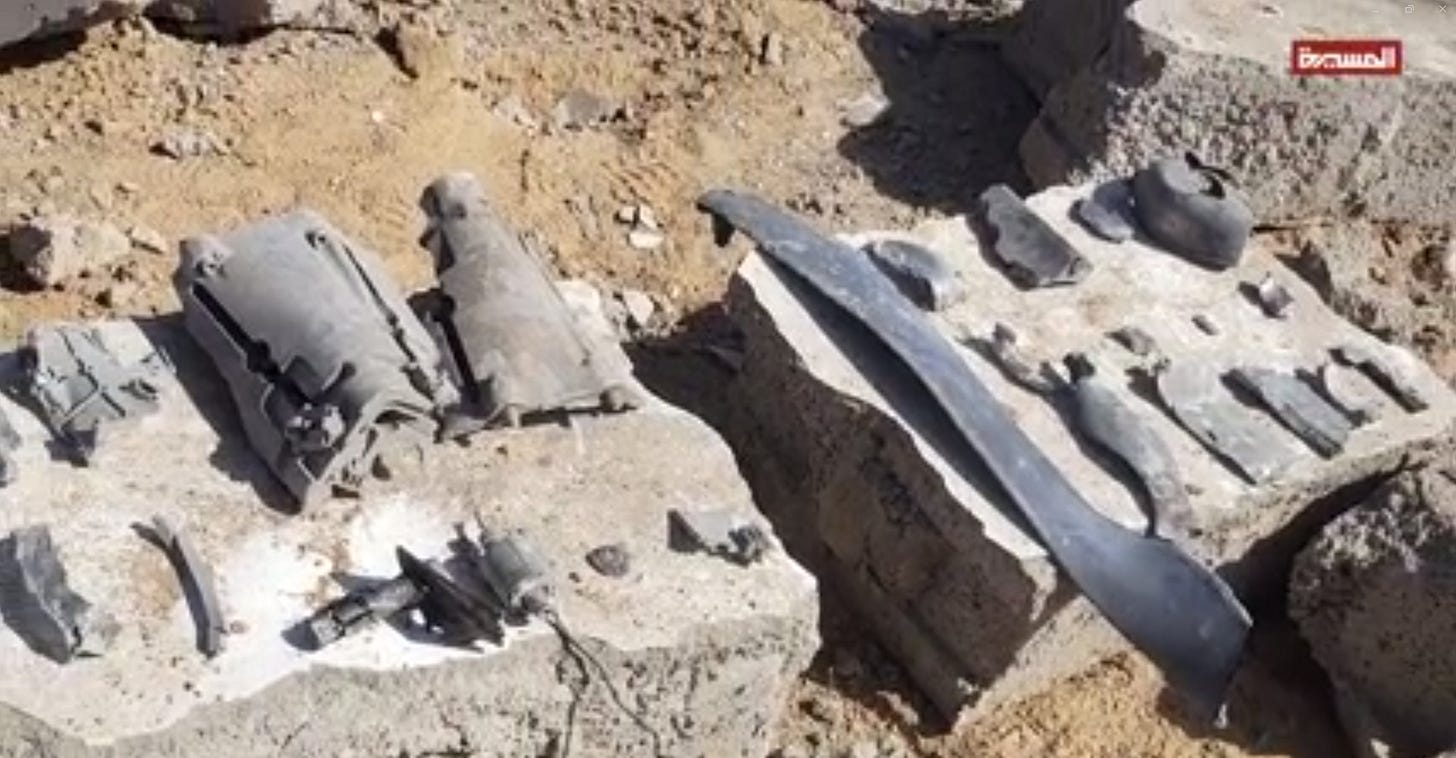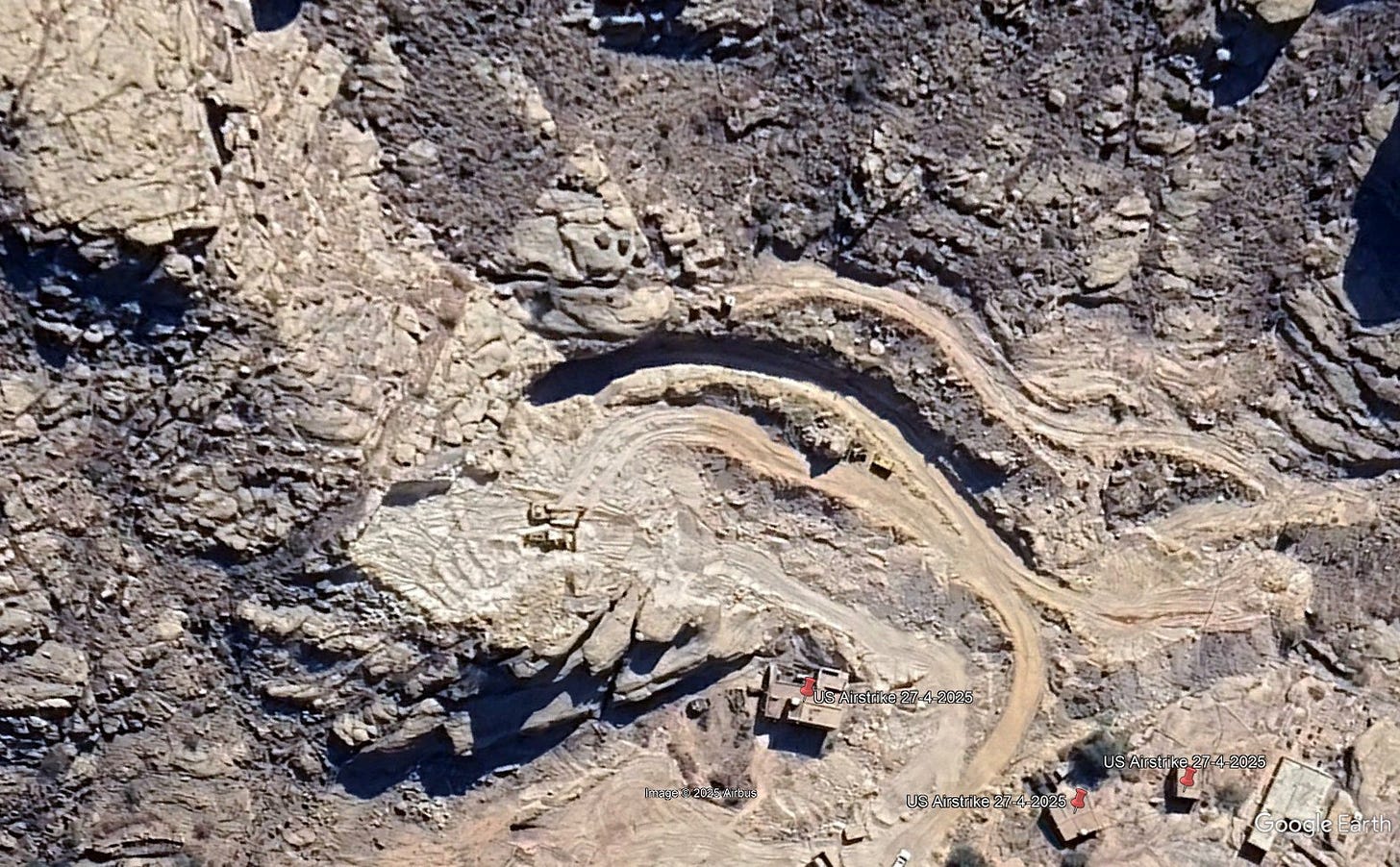Pentagon May Have Drawn on Anonymous Social Media Accounts in Planning Deadly Yemen Attack
A deadly airstrike in Yemen that killed eight civilians appeared to target coordinates posted by social media analysts online.
For the past several months, the U.S. military has been carrying out a bombing campaign in Yemen ostensibly aimed at forcing the militant group Ansar Allah, also known as the Houthis, to stop their military intervention on behalf of Palestinians under Israeli assault in Gaza. This campaign has conducted strikes against more than 800 targets, as well as verified claims of civilian harm, including, most recently, a strike against a detention facility housing African migrants that killed dozens of people. (Shuaib Almosawa in Sana’a and Amanda Sperber have more on that below.)
It would be comforting to think that the decision makers in the U.S. military are carrying out these strikes with great care—and with the highest quality of intelligence—given the power of life and death that its operations hold for innocent people. Yet, serious allegations have emerged that the U.S. military has been relying, in part, on anonymous X accounts who post coordinates that they dubiously claim contain military assets.
This week, U.S. warplanes bombed a location alleged by two such amateur open-source intelligence accounts to be a Houthi stronghold, killing innocent bystanders in the process.
A Twitter account—operated by an individual whose bio says they are based in the Netherlands, using the handle @VleckieHond—apologized this week after the U.S. struck coordinates she erroneously suggested, in early April, were the location of an underground Houthi military position; it was not a military site. “Allright, time for me to go through the mud,” Vleckie posted. “Based on satellite imagery I'd marked this quarry as an underground base, and tweeted is out as such. I'm fairly certain Centcom doesn't take their targeting data from Twitter, but this still is a very severe mistake.” Vleckie had highlighted the coordinates in a thread that claimed to have uncovered a Houthi base, and they had relied, in part, on a secondary account, @Galal_Alsalahi, whose bio suggests they are based in Houston. That account, which is hostile to the Houthis, claimed to have discovered a Houthi missile launcher at the coordinates.
The strike that took place on April 28 reportedly killed eight civilians in their homes on the outskirts of the capital of Sana’a. Vleckie’s reading of satellite imagery, the account later said, was incomplete—they said they had privately marked the target as only “possible”—and they would strive to do better in the future, while posting a screenshot of a 500 Euro donation to charity that she had made as penance. “I should never have posted it,” they added. (A message seeking comment from the account went unanswered.)
Reports from local Yemeni news outlets highlighted the devastating impact of the attack. Among the dead and wounded were children, some of whom were later evacuated to local hospitals.
The U.S. military and CENTCOM have ultimate responsibility for verifying the information used to conduct airstrikes. The Pentagon has spent hundreds of millions of dollars on advanced data analytics programs from companies, like Palantir, that include open-source data scraped from social media as part of their information-gathering process to help the military with targeting and intelligence. Data analysts live by the credo “garbage in, garbage out,” which sophisticated intelligence collection is intended to overcome.
To be sure, it may be a mere coincidence that the amateur sleuths identified the location before CENTCOM struck it, but the account used for the Sana’a strike is known to officials in the military, increasing the potential likelihood that it was relied on—at least, in part—for the tragic targeting. @VleckieHond has been publicly cited by reputable military-linked publications, including the influential Combating Terrorism Center at West Point Sentinel, which referred to the “ever-resourceful analyst @Vleckiehond,” in an April 2024 report citing her analysis on U.S. air operations against the Houthis. The report noted she had compiled her analysis based on her purchases of commercially available satellite imagery.
The paper “Assessing the Houthi War Effort Since October 2023,” used the “ever-resourceful analyst” to back up its identification of Houthi military assets. The last sentence, with emphasis added, is sourced to Vleckie and Vleckie only:
“Training and depot locations for the Houthi naval and coastal defenses forces at locations such as Hodeida’s Ras al-Khatib naval base and the Khor al-Jabana naval and coastal defense complex across the inner anchorage, both relatively visible locations. A second major headquarters area is the Ras Issa military zone and the adjacent Kamaran Island military zone, both large areas that are subject to closure to non-military personnel during security operations. These sites have been prepared for precision attacks through the creation of hundreds of identical weapons storage “igloos” (buried shipping containers).”
In April, CENTCOM announced it had struck the Ras Issa fuel depot with devastating force, killing at least 80 civilians and plunging the country into a fuel shortage that will exacerbate a hunger crisis.
The author of the West Point paper, Michael Knights, remained confident in @Vleckihond, despite how this week’s attack had gone wrong. “Impressive voluntary self-critique and professionalism. Rare to see and another positive indicator regarding @VleckieHond,” he posted, after backlash over the civilian killings and her subsequent charitable donation.
Analysis from @Vleckiehond has been cited by other publications that draw upon what is known as the open-source intelligence (OSINT) community to provide additional information used for assessing airstrikes abroad, often through analysis of publicly available satellite imagery.
Drop Site asked the Pentagon if the strike it carried out that reportedly killed numerous civilians had been drawn from social media analysis. A spokesperson did not respond. Prior claims that the U.S. had already been using social media accounts as a resource for developing strike targets had already surfaced in recent months, amid the bombing campaign in Yemen. An account identified as run from Houston, Texas, @galal_alsalahi, had also posted on April 1 about what he described as a launch pad for missile attacks operated by the Houthis, and his account had been cited by @vleckiehond in her own analysis.
The air war in Yemen has ramped up at the same time that the U.S. Department of Defense under Secretary Pete Hegseth has loosened restrictions around military strikes that had been aimed at minimizing civilian casualties. Despite the U.S. carrying out hundreds of strikes, many of which are alleged to have hit civilians unconnected to the Houthis, the militant group has maintained its blockade on the Red Sea and continued to fire back at U.S. drones and naval vessels taking part in the campaign. Houthi political leader Mohammed al-Bukhaiti told Drop Site that it would stop firing on U.S. ships if the Trump administration stopped bombing. The offer mirrors peace proposals offered publicly both by Trump and Hegseth, yet the war continues.
U.S.-Made Bomb Fragments Identified at a Strike on a Migrant Facility in Yemen That Killed Nearly 70 People
By Shuaib Almosawa and Amanda Sperber
Earlier this week, a pre-dawn airstrike on a detention center in Sa’ada, northern Yemen killed nearly seventy African migrants. The Houthis blamed the attack on the U.S., while the U.S. said it was “aware” of the claims, but has not confirmed its involvement. Munitions experts, however, said that the fragments of a bomb found at the site were from the U.S.-made GBU-39.
Verified footage from the aftermath of the strike showed lifeless bodies and thin, dismembered limbs strewn across bloody debris, as injured and stunned men and women huddled in the wreckage.

The center itself was hit at least three times in slow succession according to Sanaa, an Ethiopian activist based in Yemen’s capital who spoke with fellow survivors. The subsequent strikes hit survivors and halted the rescue operations. “Of course, this place is neither a legitimate target nor humane; it is a complete failure,” said the activist, who asked to be identified by her first name only. Sanaa also commented that an additional strike was carried out near the center.
There is no capacity to manage the devastation, Ismail Al-Warafi, Head of the Republican Hospital Authority in Saada, told Drop Site. One of the airstrikes hit the prison gate, which delayed the rescue and transportation operations, he noted. The prison’s ambulance was also destroyed. The amount of rubble created the need for cranes to dig people out from the ruins. “The situation there was catastrophic. Everyone was shocked—what was the point of targeting these peaceful Africans? It was a tragedy,” Al-Warafi said.
Al-Warafi pointed out that the support offered by humanitarian organizations at this critical moment is insufficient; the United Nations suspended all humanitarian operations in Saada in February after Houthis detained UN workers. Only the International Committee of the Red Cross showed up, he said, renting a morgue refrigerator and providing some medications barely enough for ten people. "The rest of the organizations did nothing. We hold the international organizations responsible and consider them complicit in the crimes of aggression.”
Given the extent of the damage, it appears that multiple GBU-39 bombs were used, affirmed Trevor Ball, a munitions researcher and a former U.S. army explosive ordnance disposal specialist. Ball told Drop Site he thinks the detention facility was intentionally targeted, since GBU-39 are precision munitions and the site was hit multiple times.
GBU-39 bombs have been used by Israel in Yemen, but it appears this is the first evidence of their use by the U.S. in the last year, noted Ball.
The Pentagon did not respond to a request for comment regarding the use of GBU-39 bombs.
Yemen is a pivotal transit point for migrant workers from the Horn of Africa—forced from their home by conflict and climate change that has ruined their livelihood—often journeying to neighboring Saudi Arabia to look for work. Tens of thousands make the crossing every year, risking death, abuse, and detention along the way.
U.S. Central Command (USCENTCOM) has refused to disclose details on the strikes, but it has acknowledged carrying out more than 1,000 hits on targets in Yemen since it launched Operation Rough Rider in mid-March. The Yemen Data Project, which tracks airstrikes in the country, reported that more than 158 civilians had been killed in Trump’s bombing campaign. The group also recorded at least thirteen strikes on civilian objects between April 1 and April 22.
The migrant center in Saada had been hit before in 2022. “We saw the terror and shock on the faces of the injured Africans. It never occurred to them that they could be a target,” Al-Warafi, the head of the Hospital Authority, told Drop Site. “But the incident reminded us of the similar attack. We saw headless bodies and others reduced to scattered limbs.”
"The Saudis bombed that detention center in 2022, and the ICRC has been visiting it regularly. You would have thought that would have gone on the CENTCOM no strike list. Or maybe they were willing to absorb that amount of civilian casualties. At a minimum this tells a story of some sort. It's pretty damn worrying,” Brian Finucane, a senior advisor at Crisis Group’s US Program, told Drop Site.
Niku Jafarnia, a Yemen researcher at Human Rights Watch, likewise told Drop Site that “Dozens of civilians killed while working at a port, and dozens of migrants killed in a detention center within two weeks, amongst dozens of other strikes that have killed civilians, is not just an anomaly: it’s a pattern demonstrating that the Trump administration appears to have an even greater disregard for civilian life than his predecessors.”





She pays 500 Euro as “penance”? On a religious level this would be blasphemy, kissing off so many uninvolved people, now murdered by her hand.
Legally speaking in the EU she would face life imprisonment.
Washing her hands with a token fine is both the worst insult to every surviving family member and a telltale sign of Western privilege/arrogance.
This is so gross. I shouldn't be surprised, but yet here I am.